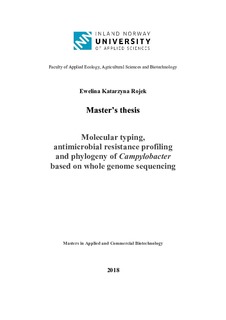| dc.description.abstract | Campylobacter jejuni and Campylobacter coli are zoonotic pathogens causing
diarrhoeal illnesses. Between 2009 and 2017 campylobacteriosis affected a total of 26,676
people in Norway, mostly involving C. jejuni. Increased number of Campylobacter resistant
to several antimicrobial drugs has become a public health concern, and further research into
molecular mechanisms conferring resistance is needed.
In this study, whole genome sequence (WGS) data from 35 C. jejuni and five C. coli
isolates were used for: i) molecular typing using the core genome multilocus sequence typing
(cgMLST) methodology; ii) conduct evolutionary relationships analysis between isolates
based on core genome and single nucleotide polymorphisms; iii) identification of
antimicrobial resistance genotypes, to correlate to resistance phenotypes; iv) identification of
cluster thresholds for outbreak detection. The higher discriminatory power of WGS revealed
that two isolates which had been phenotypically classified as C. jejuni were, in fact, C. coli.
Moreover, phylogenetic analysis enabled to separate the epidemiologically related
strains from those which were non-related, resulting in the identification of three clusters.
Reference-based cgMLST approach with 637 shared loci established that epidemiologically
linked isolates within an outbreak differed by ≤ 2 allelic variations. A similar number of
genomic differences (≤ 2 SNPs) was observed by SNP-based phylogeny. Antimicrobial
susceptibility testing followed by the detection of resistance genotypes revealed that 26/40
isolates were resistant to at least one antimicrobial drug and a total of 9 isolates were multidrug
resistant. Mostly, antimicrobial resistance was linked to resistance genes such as oxa-61,
homologs of tet and aph, and genes encoding cmeABC efflux pump system; however
phenotypic resistance towards erythromycin, tetracycline, and gentamycin was detected
within isolates that did not carry cme, tet, or aph genes homologs.
This study shows that WGS, could be used for phylogenetic inference using tools such
as multilocus sequence typing; WGS is also useful for investigation of bacterial outbreaks and
provides high resolution for purposes of surveillance, prevention, and control of bacterial
illnesses. | nb_NO |
